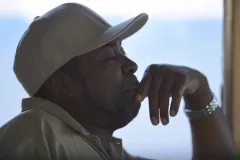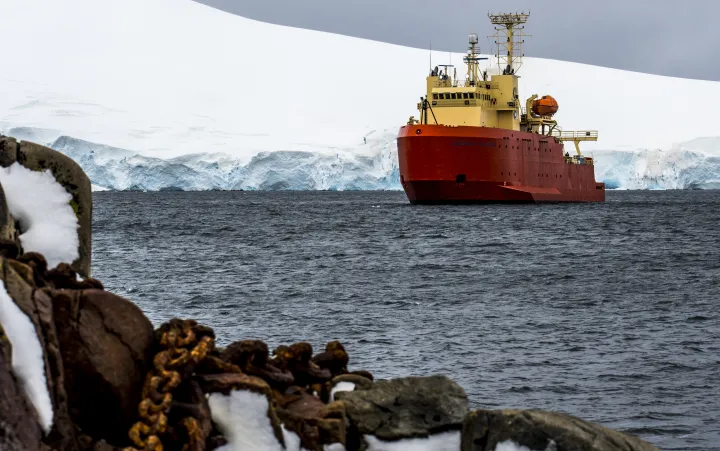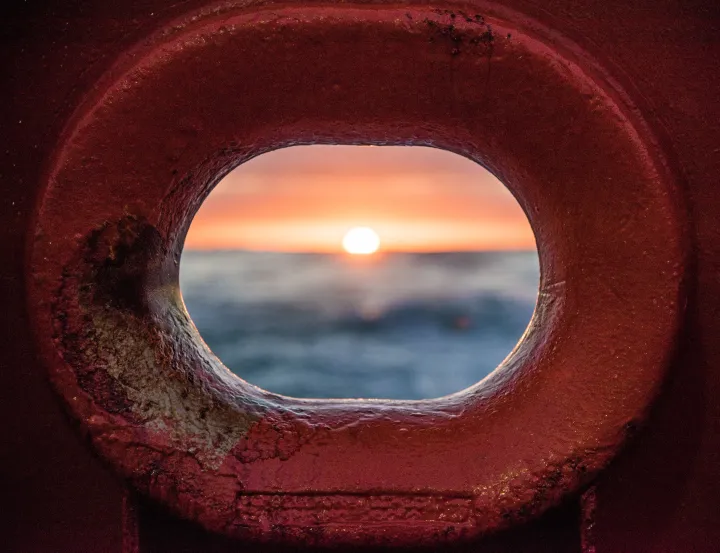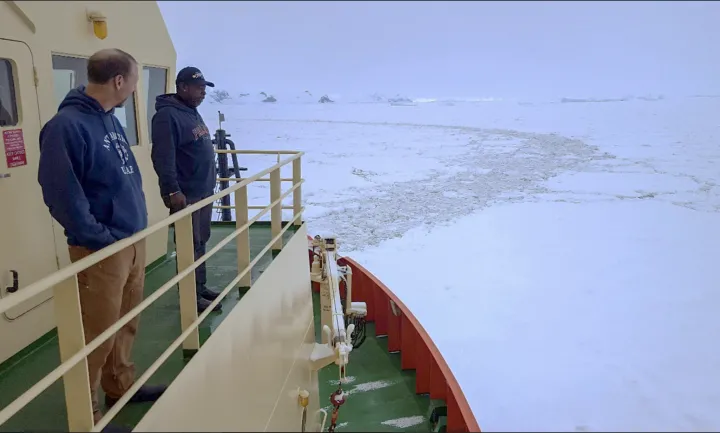A Captain’s Journey to the Antarctic

In the seas of Antarctica, nothing is assured. The weather is fickle, changing from sunny skies to whiteouts in the blink of an eye. Ice is not just ice—it forms in bergs, floes, pancakes, and sheets, each one distinct from the other. For seafarers from half a world away, these obstacles make it a tricky place to travel, and the uncharted seafloors mean extra caution and experience are needed to explore the extreme environment and make it safely back home.
Ernest Stelly sits at the helm of one of the few vessels that supports scientific research in the oceans of Antarctica. From the captain’s chair on the bridge of the ARSV Laurence M. Gould he surveys the path ahead, noting the thickness of ice, nearby icebergs, and the wind. In a flat brimmed Dallas Cowboys hat, gold chains around his neck, and a cigar at his lip he is a man of style, and not necessarily what you’d imagine at the wheel of an expedition to the bottom of the world. But the individuals who have worked with him over the years trust him with their lives. Decades of working in Antarctica means Stelly has an innate knowledge about safely navigating the treacherous waters, ensuring all on board are safe, from the engineers to the scientists conducting experiments from the stern of the ship’s deck.
“Ernest has this incredible intuition that I'm sure he's developed because he's been there for so long. He has just an incredible ability to weigh the risks and the rewards associated with the various demands that people place on him,” said Dr. Bill Fraser, who has sailed on the Gould for decades while conducting research on the ecology of seabirds.
There are two National Science Foundation research vessels that regularly voyage to American research stations and service scientific studies at sea. The ARSV Nathanial B. Palmer is a true ice-breaker, 308 feet long with powerful engines and an ice reinforced hull while the Gould is 230 feet with an ice strengthened hull. From these two ships, scientists study the Antarctic Ocean, also known as the Southern Ocean, including the whales that spend the summer gorging on Antarctic krill and the microscopic algae that form the basis for the entire food web. The scientists are accompanied by a crew and contractor deckhands.
Stelly has spent much of his career aboard the Gould, shepherding researchers from Chile across the perilous Drake Passage, one of the roughest bodies of water in the world, to the United States’ research base, Palmer Station. Today he is considered one of the most experienced seamen in the Southern Ocean, having spent around 35 years aboard various vessels. As a kid Stelly loved Star Trek and he sees himself as a Captain Kirk-like figure, always needing to explore new places amidst the perennial pursuit of the unknown. It is this need for adventure that led a young boy from Texas to a career at sea.
His ascent to captain of such a large vessel was anything but ordinary. Most captains earn their initial sea time and credentials through an expensive four-year maritime academy. But Stelly is what people in the maritime world call a “hawsepiper.” A hawsepiper is a hole in a ship’s bow where the anchor chain passes through. Stelly symbolically climbed up that anchor chain, slowly rising from an entry level position to the ship’s leader. Even within this designation he is a standout. Most hawsepipers start out as deckhands. Stelly began as a cook. After a term with the Navy and a few odds and end jobs, such as a collector for a repossession agency, he was drawn to a newspaper ad for a cook position aboard a ship and applied.
“The first thing I did is I went to my grandmother and said ‘look I need some cookbooks.’ My grandmother gave me a bunch of cookbooks that I went to the boat with. I sat on the boat and I said, ‘if I can read, I can cook’.”
For 15 years Stelly would work as a cook, first on the Amy Chouest and then in 1992 he moved to the Nathaniel B. Palmer in Antarctica. Soon he would start working other jobs on the boat as a deck-hand. But with a second kid on the way and pay raises limited for deck-hands, Stelly realized he would have to become a mate or captain to achieve a better salary. The frigid Antarctic weather was also a factor.
“That’s one of the things that really motivated me—working on deck. Being out there in that cold weather. Washing this boat, moving cargo, wind at Palmer Station blowing. As soon as I come off the deck, I’d go right back and start studying. I thought, ‘I got to get my license, I can’t take that deck!’”
After years of studying in his free time, shadowing more experienced mates, and countless exams, Stelly would earn the coveted position as a captain of the Gould in 2014. His unique background would shape Stelly into the knowledgeable captain he is today as one of only a handful of Black icebreaker captains throughout history. He is one of only a few people that understand every inch of the ship, from winches on the back deck and the machinery in the engine room to the freezers in the galley.
“I’ve done a little work in the engine room, I’ve done work in the galley, I’ve done work on the deck, and I’ve done work on the bridge. You have an opportunity to touch every department. So, when you talk to your deckhands or your cooks, you’re able to relate to them because you’ve been in that department before.”
Perhaps his most admirable feat has been winning the respect of the scientists aboard his vessel. Safety is paramount to a ship’s captain, and often that is at odds with the desires of researchers needing to collect their data. Many scientists must secure hundreds of thousands of dollars in funding for one, short chance to study the unique environment of the Antarctic. Scientists will also trek out to remote locations, sometimes boarding small zodiac boats to maneuver close to islands in shallow waters. This is especially true when studying penguins. Penguin colonies are often hard to get to, even in ideal weather. Time on the Gould is in high demand and often the date scheduled to trek out to a field site is the same day the ice and wind decide not to cooperate.
Stelly seems to thrive in these situations, calmly weighing the risks with the needs of the scientists and trusting them in instances where others may be overly hesitant.
“He puts a lot of trust in other people, and you recognize that and you want to live up to his expectations,” says Josh Mitchell, a research technician who has worked on Stelly’s ship.
Mitchell remembers a time during one situation where Stelly prepped the team for a zodiac excursion from the Gould to an island in icy conditions. The ice was so thick, Stelly had to first clear a path with the Gould’s thrusters before Mitchell was able to maneuver the small zodiac boat ashore. It was a difficult journey, and Mitchell still had to push pieces of ice out of the way with the nose of the zodiac, but due to the thorough planning with Stelly, he was prepared to safely make the trip.
“It's a form of leadership that I think takes decades to develop and one that I constantly try to emulate. I think that really fosters a positive workspace and ultimately a high level of performance by everyone that's on Captain Ernest's team.”
And, that is the true skill of a good captain, to not only guide the ship safely through knowledge of the sea, but to do so with the respect and trust of all those aboard the vessel.
According to Fraser, Antarctic science owes a lot of its advances to Stelly, “I honestly feel that what we've accomplished as scientists in terms of the data that we've obtained from the Western Antarctic Peninsula without a doubt, if it wasn't for Ernest, I wonder if we would have been as successful.”
_________
Editor's note: This article was co-written with Danielle Hall




